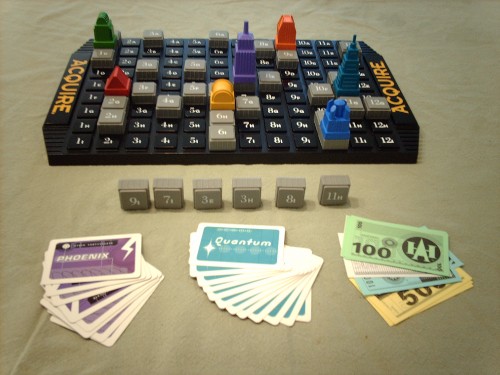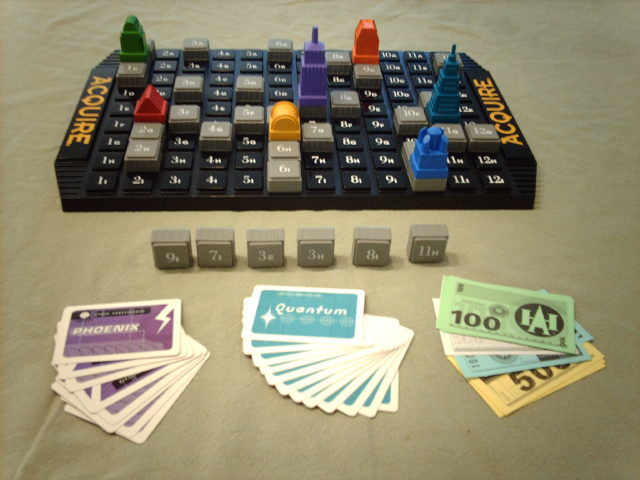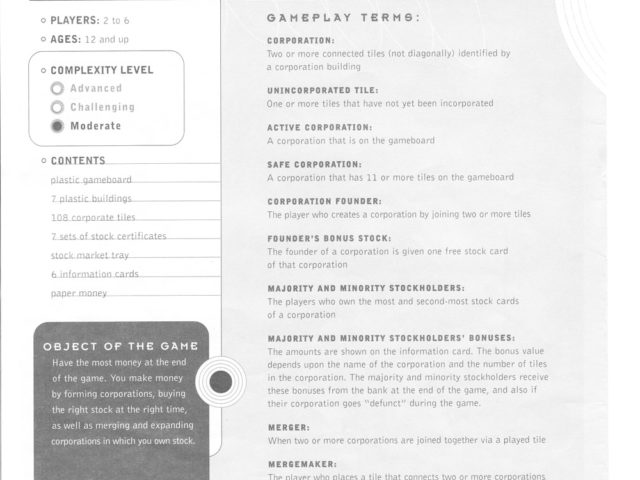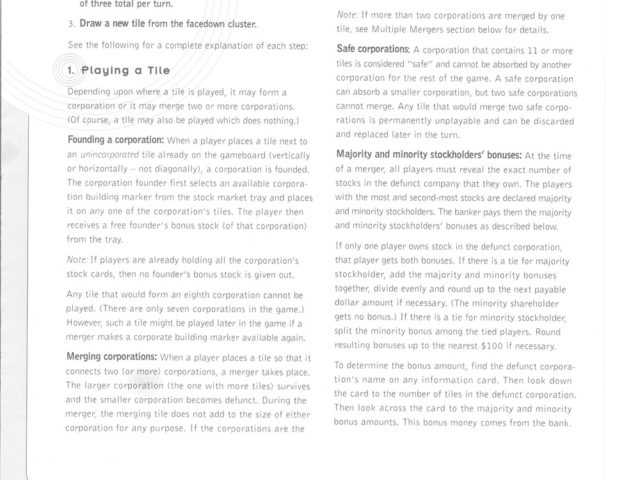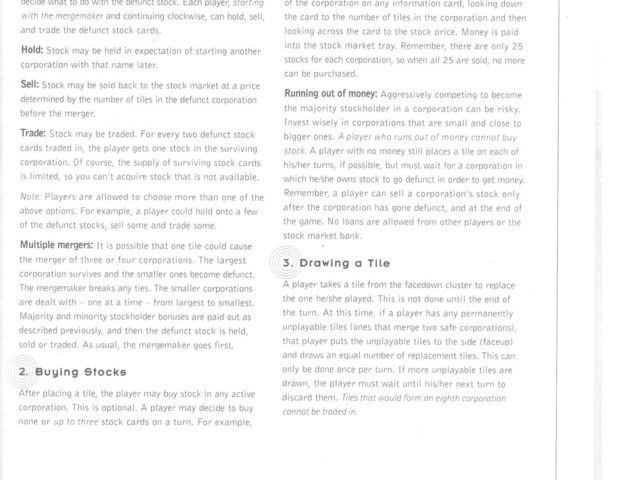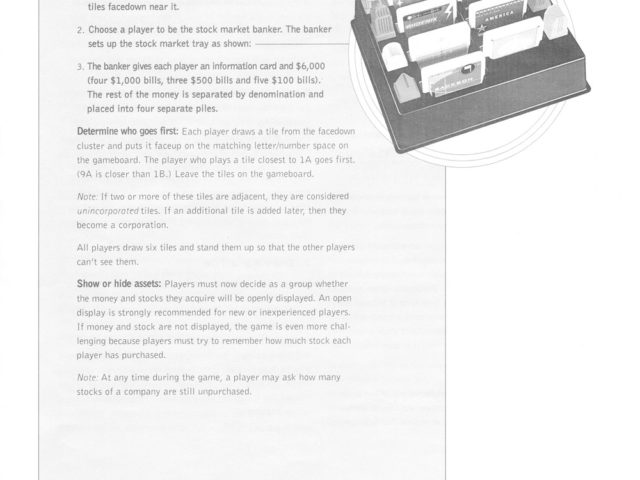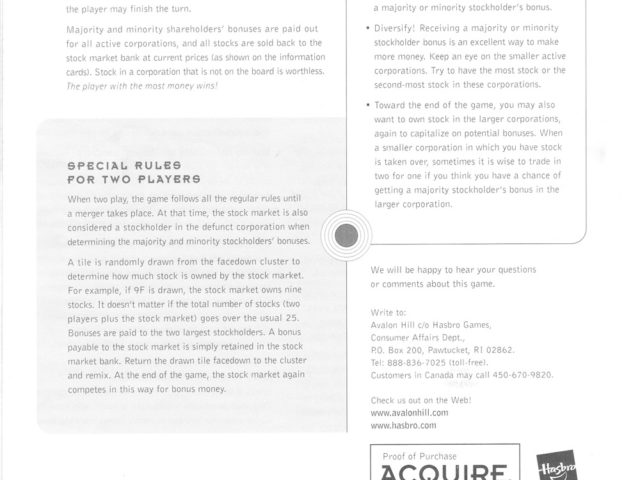Since its release in the early 1960s, Acquire has inspired generations of game designers and enthusiasts with its elegant and replayable design. Many game designers, including Ticket to Ride designer Alan R. Moon, cite Acquire as a seminal work in the evoution of tabletop gaming. This post provides designer-centric coverage of the game. Other useful starting points for people interested in learning more about Acquire can be found at webnoir.com and gamereport.com, among many others.
Overview
Acquire is a resource management strategy game in which players compete to earn money through the establishment and merger of corporations. By founding, merging and investing in corporations, players earn cash and stock. The game is won by the player who generates the most personal wealth by the time all the game tiles are either used or rendered unplayable.
Players
Acquire is designed to be played by 2 to 6 players. Larger groups are possible, but each additional player in excess of the recommended six compromises the pacing and balance of the system, primarily due to the limited number of tile spaces on the game board. The game requires that one player play the role of the banker, managing stock and cash transactions. This player must complete additional tasks to fulfill her responsibilities as banker, but her experience of the game is otherwise identical to the other players. Play unfolds in a turn-based manner, with the order of play being determined by random draw and seating position. Perceived imbalances caused by the differential between the players’ initial turn ranks are mitigated by the chance involved in tile selection and the random seeding of the board that precedes commencement of play.
Acquire has a unique and engaging hybrid interaction pattern. This pattern can be broken down into two overlapping parts: multilateral competition for resources and cash, and uni-/bi-/multi-lateral cooperation to build, expand and merge corporations. The multilateral competition pattern is easy to identify: by tactically placing tiles and trading stocks, each player attempts to outplay the others in order to earn the most cash. The uni-/bi-/multi-lateral cooperation pattern is a little more subtle. This kind of interaction occurs dynamically at various times throughout the game as players find themselves involved in de facto cartels and trading blocs. For example, two players might work together to pump up the value of a corporation’s stock in anticipation of a merger if they both have a substantial amount of stock in that corporation. This dynamic generates a relationship between the board and the players that does not exist in more familiar multilateral competition tabletop games. Risk, for example, visually maps individual player success via the state of the board — a quick glance at a game-in-progress tells you all you need to know about who’s powerful and well-positioned and who’s not. Similarly, Monopoly ties houses and hotels to properties which are in turn tied to individual players. This player “ownership” of sections of the board does not exist in Acquire, which is ultimately as much about the players’ collective speculation on a dynamically co-created imaginary market as it is about the rise and fall of their individual fortunes.
A typical game of Acquire takes about 30-60 minutes, depending on the speed of the players and the player-controlled “banker.” Beyond the core game mechanics, players spend a lot of time storytelling about the rise and fall of the various corporations on the board — ooh, Sackson’s expanding like the Blob. I knew it! — or the fortunes and actions of the individual players — heads up, Jeff’s getting serious about Quantum. The game tends to freeze up a bit toward the end, excluding trailing players and leading to a somewhat anti-climactic finale. That said, the inherent dynamism and complexity of the system makes the potential for victory seem within reach for most players until the late mid-game.
Objective
Simply put, the objective of Acquire is to make money by founding, building and merging corporations, and selling stock. These ends are achieved through the strategic placement of tiles and the expenditure of cash from the players’ reserves. The game is typically won by the player who holds the majority of shares in the surviving “safe” corporations, although occasional victories can be had by players who buy and sell in high volume in the early game.
Procedures
Players of Acquire participate in two central procedures, Setup and Turns. Setup occurs at the outset of the game and seeds the board with a random selection of tiles, ensuring different starting conditions for every game. The core game play then takes place as players take their Turns.
Setup
Game setup consists of a resource randomization phase, an initial resource allocation, a random seeding phase, and a secondary resource allocation:
- Resource randomization — In Acquire, players place numbered tiles onto their corresponding game board squares to expand and merge corporations. Each player has a “hand” of six tiles and plays one tile per turn. At the end of each turn, a new tile is drawn, replenishing the hand. To enforce randomness onto the allocation of these key resources, the first physical setup procedure in the game is to dump all 108 tiles onto the table and arrange them into a face-down cluster.
- Resource allocation 1 — In the initial resource allocation phase, one player is chosen to be the banker. This player will manage the exchange of cash and stocks for the remainder of the game. The banker provides each player with $6,000 in game money, divided into four $1000, three $500 and five $100 bills. With this range of denominations, players can make initial stock purchases without needing to involve the banker in making change. Given our play testing experience, players rarely need to actively “break” their larger bills. Players who run out of $100 bills will usually pick up a few in change each turn, guaranteeing an easy flow cash transactions.
- Random seeding — The random seeding phase of the setup is one of the most crucial moments in the game, as it determines the initial conditions of the stock market into which the players will be investing. The game board consists of a 12 x 9 grid of squares identified horizontally by number and vertically by letter (e.g. the square in the upper left corner is marked 1a, while the square in the lower right corner is marked 12i). After receiving their cash resources, each player randomly draws a tile from the face-down cluster and places it on the corresponding square on the game board. This procedure elegantly serves two purposes. First, it settles the question of turn order, as the player who draws the “lowest” tile (i.e. the one closest to 1a) goes first. Second, it “seeds” the board with a random selection of tiles. The result of this seeding is reminiscent of Conway’s Game of Life: complex, unpredictable patterns emerge through the combination of these initial tile placements with the other procedures called for by Acquire’s simple rule set. The result is a dynamic game board landscape that evolves to a different end-state with each replaying.
- Resource allocation 2 — Setup concludes with the players each gathering six tiles from the face-down cluster. These tiles comprise the players’ “hands,” and are kept secret. While the designers have given the players options when it comes to the secrecy of other resources — the stock cards, for example, can be left open to public view without seriously damaging the game — it is important to note that they have set firm guidelines for the tiles. If players were to know which tiles one another had, the game’s strategic complexity would multiply beyond reasonable bounds as players would be forced to consider both the strategic placement of their own tiles and those of their opponents. Such computations would seriously compromise the game’s capacity to enable intergenerational/intercompetency play experiences.
Turns
A player turn involves four steps: placing a tile on the game board, processing the consequences of the placed tile, buying stocks and drawing a new tile from the face-down cluster:
- Placing tiles — Players select one of their six secretly-held tiles to place on the board. To make this selection, players need to evaluate the consequences of placing a given tile onto its corresponding square. Tiles placed adjacent to other tiles, for example, will create, expand or merge a corporation. In the early game, the ratio of the number of empty squares on the board (depending on the number of players, this varies between 102 and 106) to the six tiles in each player’s hand is 17- or 18-to-1, meaning that the range of available moves might not contain a placement that is adjacent to another tile. This means that some players will find themselves unable to place a tile that will create, expand or merge a corporation. However, as play proceeds and the game board fills up, the ratio of squares-to-tiles decreases, ramping up the frequency of corporate foundings, expansions and mergers. Finally, the number of tiles in each players’ hand exceeds the number of playable squares on the game board. The game ends shortly after this state is reached.
- Processing consequences — After placing a tile onto the game board, players must make the appropriate adjustments to both their own resources and to shared game tokens. For example, suppose a player places a tile next to an “unincorporated” tile, thereby creating a corporation (so long as fewer than 7 corporations are on the board). In this case, the player must first select a corporation token from the remaining tokens contained in the banker’s box, then place that token on top of one of the tiles in the newly-formed corporation. Finally, the player will collect a single stock card for the corporation that they founded. These resource and token manipulations take place almost every turn during the mid-game, when most moves will create, expand or merge a corporation.
- Buying stocks — Players must decide which new stocks (if any) they will purchase by analyzing the projected fortunes of corporations (as represented by the tiles and tokens on the game board) and investors (as represented by the “stock portfolios” and piles of money that sit in front of the players at the table). A common strategy in this regard is to identify smaller corporations likely to be consumed by “safe” corporations (corporations with more than 11 tiles), and then to buy stock in them. This stock can then be sold or exchanged (at a markup of 2 to 1) for stock in the larger corporation when a merger occurs. Players are slowed from achieving unshakably dominant majority shareholder positions by a rule that limits the purchase of stocks to a maximum of three per turn.
- Drawing a new tile — Players replenish their hand at the end of their turn. As the game approaches its conclusion, some players will find that they have tiles in their hand that cannot be played due to the safe corporation rule. The safe corporation rule states that two corporations that have 11 or more tiles cannot merge, and no tile that would otherwise cause them to merge can be placed on the board. Players who have such tiles in their possession may trade them in for another randomly-picked tile at the end of their turn. This procedure ensures that players who are stymied by the arrangement of safe corporations on the game board can remain engaged and hopeful that they will receive a better tile on the exchange. Crucially, however, this exchange is limited to one tile per turn, which prevents players from quickly cycling through the available playable tiles during the endgame. This rule effectively injects another element of chance into the increasingly deterministic final stages of the game.
Rules
Acquire‘s compact rule set generates entertaining, social and multi-layered play experiences. It is a minimalist blend of Go and Monopoly. Unlike economic simulation games that generate complexity and nuance through the proliferation of objectives and constraints, Acquire creates rich interactions via a set of simple mechanics. The rule set generates lively multiplayer-Go-like board play through a few simple rules concerning the placement of tiles and the consequences thereof. It generates an active card-and-cash market by simply constraining how and when stocks may be bought. Most importantly, it links these two play activities — board play and card/cash game — so tightly that the one could not exist without the other. ((This essential interdependence of rules, boundaries and game resources does not preclude looseness or “give” in the system. The 1999 Hasbro rulebook, for example, leaves it up to the players to “decide as a group whether the money and stocks they acquire will be openly displayed.” Numerous modifications and editions discussed online suggest that the system can tolerate a lot of bend-and-tweak before it breaks. And yes, I just said, “bend-and-tweak.”))
Resources
Acquire has three key game resources: tiles, stocks and cash.
- Tiles — Having playable, strategically-relevant tiles can make all the difference, especially in the early game. Unlike stocks and cash, a player’s collection of tiles is determined through random draws. As noted above, injections of randomness such as this help to offset the potentially deterministic outcomes generated by board play mechanics alone.
- Stocks — Stocks accrue value as their issuing corporations expand. Corporations that grow beyond 11 tiles in size become “safe corporations,” meaning that they can not be consumed as the consequence of a merger (and that they cannot engage in a merger with another safe corporation). Players will attempt to corner the market in stocks for the most valuable safe corporations (i.e. not all stocks are made the same), while quickly flipping the lower-valued stocks of minor corporations through mergers and acquisitions. ((Obviously, the safe corporation rule also has key design implications when it comes to the evolution of the board play aspect of the game. I haven’t done the math on this, but I would guess that to allow two corporations of more than 11 tiles to merge would create a monopoly situation at around the same time turn-wise of the actual rule set’s mid-game. As the end-game draws near, this key constraint accelerates the pace at which the number of playable squares decrease, bottle-necking the players into an increasingly small array of possibilities with — at least for some — an increasingly large potential payoff.))
- Cash — Cash is necessary evil — albeit a highly-appropriate one, given the subject-matter of Acquire. As a game resource, it tracks the results of the players’ stock market activities. Cash may not be traded among the players, and aside from the up-front money given to them during the setup of the game, the only way players can earn money is through buying and selling stocks, or earning bonuses. Extra cash bonuses are given to the majority and minority stockholders when a corporation goes defunct following a merger. Tracking and processing cash transactions and stock values sometimes threatens the quick pace of the game, but the designers have done their best to mitigate this problem by providing simple charts specifying the going rates for stocks, majority and minority bonuses, and so forth.
Boundaries
Acquire’s boundaries are pretty standard: play is constrained to the tabletop, with the board as the central focus. In so-called “open display” games, the players’ money and stocks are a second circle of interest. In all versions of the game, the players’ personalities and knowledge of one another — both of which have roots that often go well beyond the shallow temporal constraints of a 45-minute board-gaming session — are also circumscribed by the magic circle.
Outcome
Winning Acquire depends on a combination of strategy and luck. A good draw of tiles properly played will put any player into potential victory position. Nevertheless, sudden shifts in fortune can occur well into the late game, leading to upset victories and close seconds. This randomness is essential to the game’s design as it confounds the deterministic tendencies inherent in small-grid proximal-square set-making board games (or SGPSSMBGs™ for short).
1999 Hasbro Ruleset
Formal element breakdown schema: Tracy Fullerton, Game Design Workshop.
Scans: thanks, E.
If you own the copyright to any of the materials presented in this post and want me to remove them from public view, please let me know via email and I will do so.

